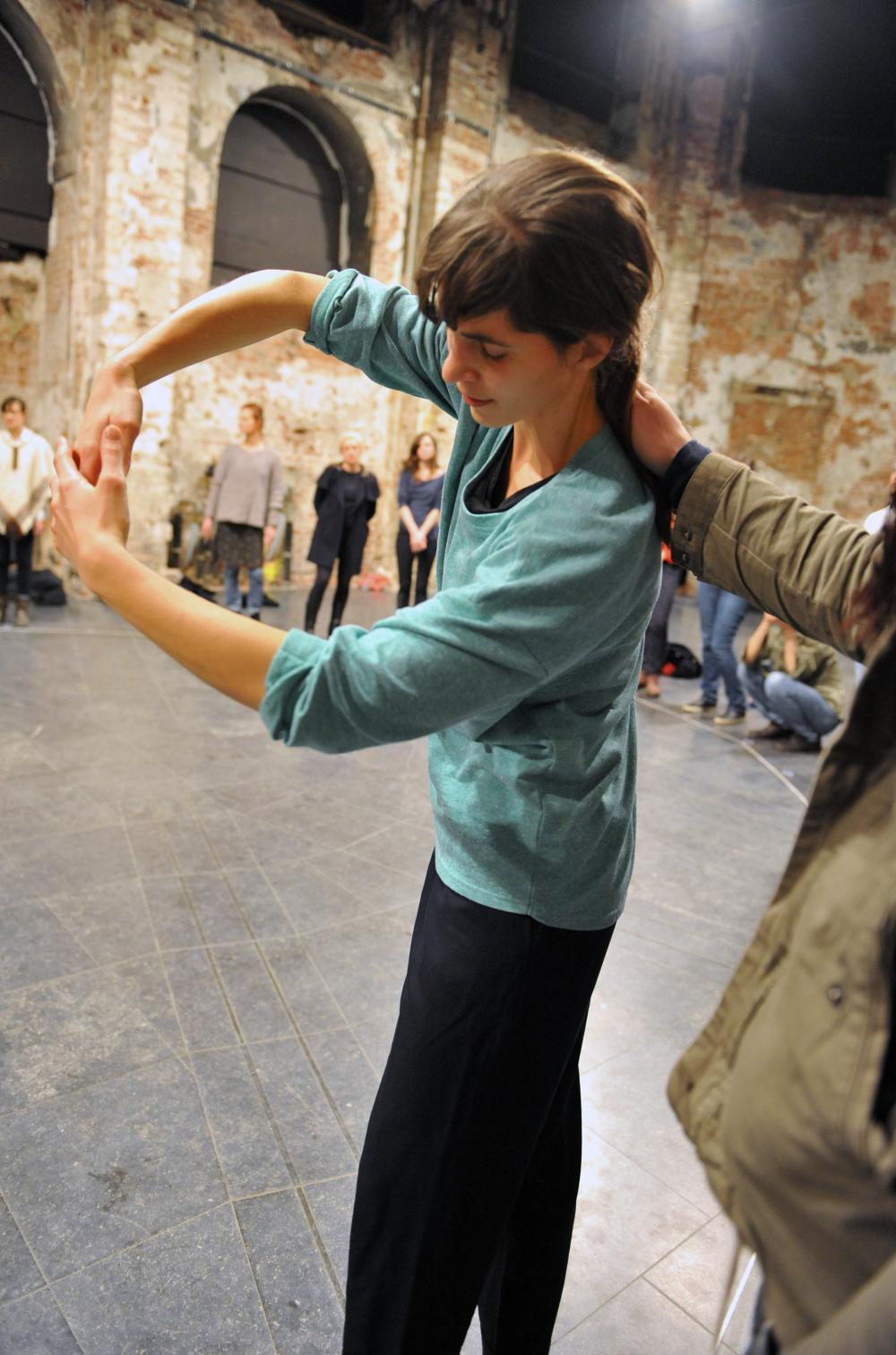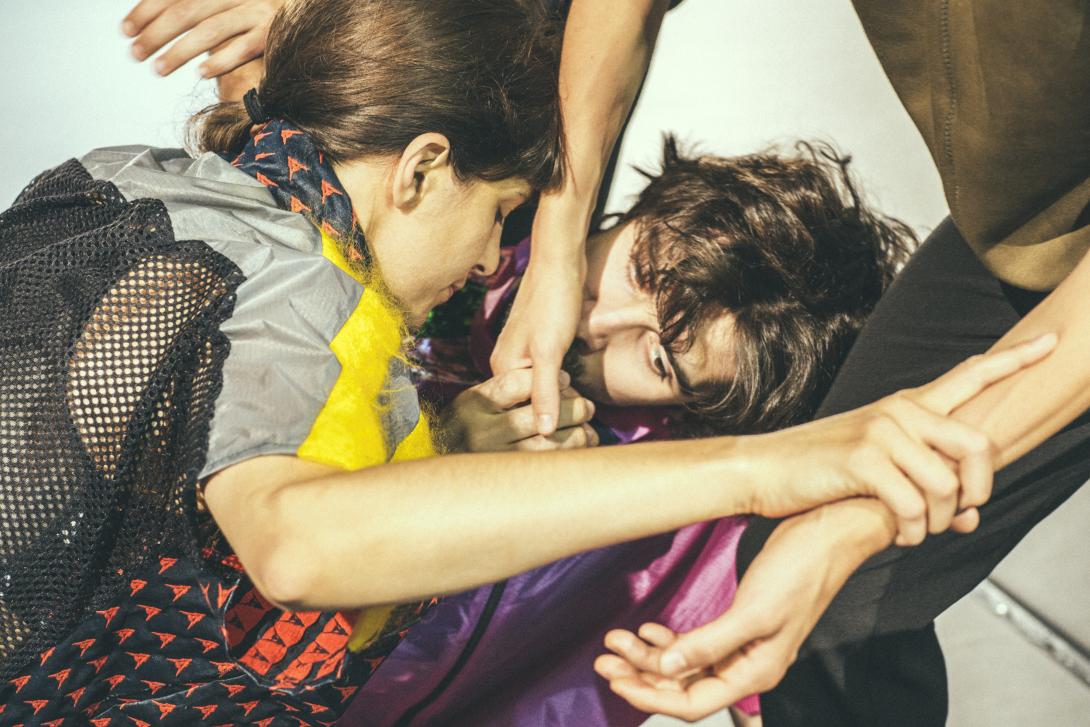‘ WE CARRY THE TRACES OF THESE ENCOUNTERS WITH US’
A performer reaches for your hand. She lets it slide over her arm, across her shoulders and down her other arm.
This is one of several tactile encounters that are proposed in Vera Tussing’s performance The Palm of Your Hand. Tussing was invited to recreate this performance in a version that would include a blind and partially sighted audience. In this interview, she gives us an insight into the recreation process: ‘There is always a balance to be struck between ensuring that you do not ignore people’s specific needs, and not calling attention to people who don’t want it’.
Touch and encounter are key in The Palm of Your Hand, as in many of your works. Where does this fascination come from?
There has been a long trajectory in my work that explores how dance and performance can be perceived via different senses. This curiosity goes back more than ten years, and predates the invitation to recreate pieces to include blind and partially sighted audiences.
In 2007, I collaborated with Albert Quesada on a trilogy of three short pieces: Beautiful Dancer, Your Eyes and Oh Souvenir. The focus of this exploration was to consider dance as an acoustic experience. I took this idea further in Sound Bed, a sound-movement installation from 2011, in which dancers move speakers on wheels around a single audience member, to choreograph an acoustic journey around them.
My last three creations all evolved around ideas of tactility, connectivity and how the audience can be invited into physicalized networks of tactile relations and encounters. Where T-Dance (2014) engages in one-to-one encounters but still operates in the classic theatre staging, the idea of dance as a tactile encounter was further developed in the ‘tactile dance piece’ The Palm of Your Hand. The audience surrounds the performance space in an ellipse shape – and is always in immediate proximity to the unfolding work. The dancers enact tactile encounters with audience members, while following a choreographic structure. Mazing (2016) also explores this kind of theatrical set-up – but with less of a fixed choreographic structure, and more room for the negotiation process between performer and audience.
In 2016, Kaaitheater and The Place invited you to take part in the European network The Humane Body, which seeks to open up the experience of dance performance to a visually impaired audience. In this framework, you made a reworked version of The Palm of Your Hand.
We – my team of performers (Gorka Gurrutxaga Arruti, Zoltan Vakulya, Solene Weinachter) and I – didn’t have long for the recreation process, and it was clear to me that I needed advice on how to proceed. Alongside with most of my recent work, The Palm... is a show that is very much perceived in an interactive way. In addition, there are certain work processes that suit my way of working and I decided to stick to them. The most valuable way for me to inform myself about the recreation process was to show the performance in its current state with an audience from the blind and partially sighted community. After the performance, we began a dialogue on how to ‘remake’ the work to let it communicate beyond sight.
What did you learn during the recreation process?
Lots! And there is still more to come. Learning how to negotiate through touch is a very intense process, and puts us in a heightened sense of presence and dialogue with whomever we are in contact with. I enjoy the fact that the work enables this mode of communication. I also enjoy the challenge that it places on us as performers. Every time we perform this show, we as performers touch and get touched by around 60 people. We carry the traces of these encounters with us.
One of the first things we learned in the re-creation process was how much we were communicating visually in the piece – and indeed in our process – despite the fact that this was an exploration of tactility. There is an almost unconscious set of assumptions around sight that one doesn’t even notice until they are pointed out. It can be manifested in very little things, such as automatically using phrases with visual verbs when you’re talking about a choreographic pattern. We often don’t realize that our language has an undercurrent of a visual bias. In our dance training, we were also taught how to be quiet and walk without making excessive noise. But when working with blind and partially sighted people, this leads us to mask our presence completely!
Luckily, our team of experts from the community(1) was very fast and very vocal in its critiques – but also in its encouragement of how we should proceed and improve. One major discovery for us was being told to be less ‘gentle’ in our execution of the danced material and our interactions. Instinctively, we felt that we needed to be more careful – but this seemed to be completely wrong. It was a very thought provoking and really enjoyable learning process. Questioning one’s automatic assumptions can really lead to new, interesting places.
Which adaptations did you introduce to make the performance more accessible to a visually impaired audience?
Aside from reworking many of the choreographic principles of the piece, we turned the volume up on most of the non-visual elements. I worked with Michael Picknett, my long-term sound collaborator, to create additional sound tracks for the bigger movement patterns in the work, giving those actions more of an acoustic dimension. In collaboration with my light designer Bert Van Dijk, we also added a tactile dimension to the tickets, which we hand out at the beginning of the show. In that way, the audience can trace the basic set-up of the room which is the ellipse shape. It also includes some details about the basic pattern that the performers repeat within that set-up.
As the show focuses on touch, we also went through a process of reconsidering the costumes. A wider differentiation of fabrics would allow each of us to stand out on a tactile level. I also proposed that the costumes could add to the acoustic scape of the work – come and see the show if you are curious about how this works! Sofie Durnez helped me to realize the current costumes of the show. For the last part of the performance – which is a visual one – Solene Weinachter does a live audio transcription.
Prior to the performance, the visually impaired audience is invited to a touch tour, where they are given a tactile ‘image’ of the scenery and costumes.
The creation of the touch tour to introduce elements of the work to our blind and partially sighted audience members was a moment that deepened our exploration of the piece within the frame of vision and the lack of it. It also is an essential opportunity to give them the information they need to join the rest of the audience for the show.
An interesting thing we encountered was that sighted audience members frequently wanted to join this process – and then would often start closing their eyes in order to simulate blindness. Needless to say, we really had to dispel the idea that a sighted person closing their eyes is NOT a way to simulate actually being blind! Rather, the recreation was a way to explore how the same movement sequence and performative context can be experienced via different sensory moments.
Which position do you give blind and partially sighted audiences during the performance?
Very early in the recreation process, our expert team asked us: ‘Please, don’t call us out as the blind people in the room’. Personally, I am not keen on labelling and grouping people in the work (or elsewhere). Nonetheless, there is always a balance to be struck between not calling attention to people who don’t want it, and making sure we do not ignore people’s specific needs. I am very aware that this balance is not always an easy one to strike for myself and the performers, but I think – and hope – that there is room for it within the sensibility that the work proposes. The central aim of the work is to remain open enough to allow for non-sighted, partially sighted and fully sighted audiences to experience the piece amongst each other.
The essential politics of the work, even prior to the recreation process, was to make sure that we didn’t perform at people, but with them. Each touch encounter in the piece is negotiated throughout their duration. We are not assuming any form of immediate consensus in the work. We seek a negotiated encounter and always try to acknowledge the audience’s presence in the moment of performance. In order to give space for this process – the work maintains a certain hierarchy. The choreographic structure is very clear and present for the performers – but it always comes second to the touched encounter, and can hence be abandoned. We frequently have audience members who withdraw from the touch encounters, and we encourage people in the touch tour to signal to us if they don’t want to be touched. This allows the performers to be responsive and to acknowledge difference, rather than assume the audience is a homogeneous group. For me this is a sign that the work allows its audience to act and react to the performance.
(1) Saïd Gharbi, Ibrahim Tamditi, Jempie Vermeulen, Tonia In Den Kleef, Yannick Heeren

